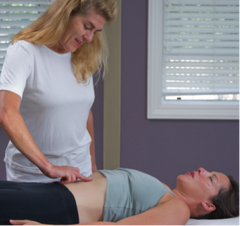 Author: Sandra Gustafson
Author: Sandra Gustafson
Bowenwork is an established form of bodywork increasingly sought by clients who desire approaches to pain relief, postural realignment and relaxation; and by bodywork practitioners seeking an effective, hands-on modality that does not unduly strain their bodies when working on multiple clients a day.
Bowenwork benefits
The technique originated in Australia, with self-taught manipulative therapist Thomas Bowen (1916–1982), and was introduced internationally by one of his protégés, Oswald Rentsch, in the late 1980s.
Bowenwork is a facilitative process, wherein the practitioner’s light, minimal moves on the body, plus pauses, coax its innate healing mechanisms toward self-restoration and relaxation. The technique notably affects the autonomic nervous system, shifting it from sympathetic dominant to parasympathetic homeostasis. During a session, clients tend to experience deep relaxation, may fall asleep, and often, tummy rumbling can be heard.
Bowenwork can be effective for recovery from multiple health issues: physical injuries, postural imbalances, illness, fatigue or stress-related conditions, according to Oswald and Elaine Rentsch’sBowtech – The Original Bowen Technique: Instruction Manual – Modules 1 & 2 (2013). The Bowenwork practitioner embraces a holistic approach to supporting the body’s intrinsic ability to heal from dis-ease, and does not only focus on areas of pain or dysfunction. The practitioner often performs moves on areas seemingly unrelated, to reset tissue-tension patterns throughout the body and support optimal function.
A Bowenwork session
The technique is performed with the client, lightly dressed, seated or lying comfortably on a massage table. When people initially observe and experience this subtle technique, it may seem a little mysterious in its minimal approach, with the practitioner applying some hands-on work, interspersed with hands-off delays.
A Bowenwork practitioner applies a series of gentle, rolling moves to specific locations, over skin, fascia, muscles, tendons or ligaments, in a manner not typically seen in other techniques. Sets of moves are followed by hands-off pauses for two minutes or longer, to allow the body to integrate multiple sensory signals, activated in proprioceptors and nerve pathways, within various layers of tissues.
In addition to feeling the practitioner’s hand movements, clients may feel a variety of sensations during a session, such as tingling, increased warmth in the extremities, tissue tension releases, increased relaxation, and less pain; or not feel anything at all. Effects of the work can be observed during a session, a little later, or even a few days afterward, as each person responds differently to the technique.
Principles of Bowenwork
A deeper look into some of the physiological mechanisms at play helps shed some light on the Bowenwork process, including an osteopathic principle put forth by John Hilton in 1863—over 150 years ago—that still holds true today.
Hilton’s Law, as quoted in “Hilton’s Law Revisited,” published in Clinical Anatomy (2014), states:
“The same trunks of nerves whose branches supply the groups of muscles moving a joint furnish also a distribution of nerves to the skin over the insertions of the same muscles; and…the interior of the joint receives its nerves from the same source.”
This concept helps us understand how gentle stimulation on skin, superficial fascia, muscles, and tendons can alter deeper tissue-tension patterns and joint realignment.
 Another neuromuscular principle is reciprocal inhibition. Part of the move involves applying pressure against muscle, tendon or ligament fibers, which activates proprioceptive spindle cells, Golgi tendon organs and spinal reflexes, resetting acute and chronic contraction patterns in muscles, tendons and fascia; and improving tone in tissues weakened by abnormal tension patterns. These outcomes are supported by the findings of the study “Human muscle spindle sensitivity reflects the balance of activity between antagonistic muscles,” published in the Journal of Neuroscience in 2014.
Another neuromuscular principle is reciprocal inhibition. Part of the move involves applying pressure against muscle, tendon or ligament fibers, which activates proprioceptive spindle cells, Golgi tendon organs and spinal reflexes, resetting acute and chronic contraction patterns in muscles, tendons and fascia; and improving tone in tissues weakened by abnormal tension patterns. These outcomes are supported by the findings of the study “Human muscle spindle sensitivity reflects the balance of activity between antagonistic muscles,” published in the Journal of Neuroscience in 2014.
It is not clear how Thomas Bowen decided to wait two minutes between sets of moves; however, a clue lies in Lawrence H. Jones, D.O.’s Strain-Counterstrain research, which measured stretch reflex amplitude waveforms to various stimuli, according to a 2006 study in the Journal of the American Osteopathic Association. Jones found, through electromyelograph testing, that it took up to 90 seconds for muscle tissue to relax after a stimulus was applied, according to the text Rational Manual Therapies (1993).
Getting started in Bowenwork
Bowenwork is safe for people of all ages, including babies, children, adults, pregnant women and the elderly. It can be used for people with acute or chronic health issues, not just musculoskeletal problems, according to John Wilks and Isobel Knight’s 2014 book, Using the Bowen Technique to Address Complex and Common Conditions. It is easy on practitioners’ bodies, and can be performed on more than one person at a time.
Bowenwork is taught by the American Bowen Academy. Professional Bowenwork Practitioner accreditation currently involves completing seven two-day modules, 100 hours of anatomy and physiology, 24 hours of business and ethics, and CPR certification. More information is available at www.americanbowen.academy.
About the Author
 Sandra Gustafson, M.H.S., R.N., a Bowenwork practitioner for 23 years, is also a registered nurse and integrative health care practitioner at Farmacopia. She finds Bowenwork beneficial for supporting clients recovering from or managing physical ailments and illness, even people very sick with cancer and degenerative neurological diseases. Click here to learn more about Sandra and her services.
Sandra Gustafson, M.H.S., R.N., a Bowenwork practitioner for 23 years, is also a registered nurse and integrative health care practitioner at Farmacopia. She finds Bowenwork beneficial for supporting clients recovering from or managing physical ailments and illness, even people very sick with cancer and degenerative neurological diseases. Click here to learn more about Sandra and her services.

